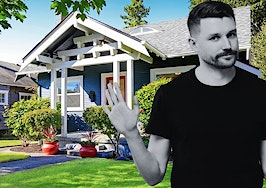Join the movement at Inman Connect Las Vegas, July 30 – Aug. 1! Seize the moment to take charge of the next era in real estate. Through immersive experiences, innovative formats and an unparalleled lineup of speakers, this gathering becomes more than a conference — it becomes a collaborative force shaping the future of our industry. Secure your tickets now!
Last year, we sold our “forever” family farm to pay for medical expenses. No one in the family wanted to do this, but what can a family do when faced with the actual costs of living in today’s costly economy? Unfortunately, finding and maintaining a forever home won’t work financially for most Americans in 2024.
In 2020, the average income required to purchase a home was about $59,000; now, in 2024, the income you need is about $106,500 even to get your foot in the door in most markets. Currently, in 2024, the average American salary is $59,428, which, if you do the math, means that finding a home you can afford, let alone your “forever home,” is like trying to find a unicorn.
In this article, we will explore why the concept of “forever” homes just doesn’t add up against the average American’s salaried purchase power, how consumers fell in love with real estate and created a multifaceted economy around homeownership, and how keeping up with the Joneses is nearly impossible for households making less than $100,000 a year.
How we fell in love
The affair with real estate started in the 1950s when young families sought single-family homes that not only met their basic needs but also had many lifestyle and design features that had never been offered at an affordable rate. Pink stoves and black and white tiled bathrooms with a garage and a yard for the dog became the goal as suburbs exploded across the country.
From the 1990s to the early 2000s, pop culture romanticized finding your forever home. HGTV built an empire on this ideal: We must find, renovate, and, essentially, live our best lives by purchasing and customizing a beautiful forever home.
The entire housing boom of the late 1990s and early 2000s (a period that abruptly ended with the housing crash and the Great Recession in 2008) can be at least partially attributed to HGTV’s celebration of the home. While Americans have always aspired to home ownership, watching real people achieve their dream homes on television 24 hours a day, seven days a week, made the goal a more tangible preoccupation. Home, which had always taken a backseat to the fashion apparel business, became just as prominent, and in some ways an even more prevalent element of the American conspicuous consumption process. — Business of Home, How 25 years of HGTV has transformed the home industry
Hollywood best captured this in 1991 as Steve Martin took on the role of the Father of the Bride, where he essentially turned his massive home upside down in renovations to hold his daughter’s dream wedding.
Then, in the sequel, the house itself becomes a main character in the movie when George Banks has to buy it back after a lucrative sale and completely renovate it again to accommodate a late-in-life additional baby.
That escalated quickly
Agents have leaned into the American dream of white picket fences and large colonials as a sign of status and success for buyers. This is kind of the lifecycle of real estate that we have normalized. Boomers have benefited from the idea of forever homes, but younger generations have struggled to keep up.
Unlike what happened with my grandparents’ family farm here in Appalachia, where they built and lived in a home for almost 70 years, modern real estate culture evolved rapidly right around them, and moving multiple times was not only expected but considered good financial advice.
- You have to have a starter home.
- Then, you need to increase the size of the home when you expand your family.
- Then it’s time for your “I’ve made it. This is my forever home” when you get that big promotion.
- Then you realize that your home is too big and too hard to maintain, and you need a “Downsized Home”
- You might want an investment property.
- You definitely want a vacation home.
- Then, in your golden years, you might meet a sales counselor like myself, and we can talk about a retirement home care package and make one last move.
This pathway was carved out for middle-class Americans who had the flexibility to move through several real estate cycles, carrying the equity they built through each transaction with them. That’s the potential for almost seven real estate transactions. That does not factor in job changes, divorces, rentals and estate planning.
The American dream around housing seems to have carefully crafted a story where someone’s self-worth or identity is woven into a physical brick-and-mortar home.
Finding a forever home, or gaming your way to it, is not the case anymore for many due to affordability and low inventory issues — even for middle-class Americans. Two things will have to happen now:
- We will have to figure out how to get past the “forever home” ideal because, in all reality, the home you can afford today may not be affordable or safe for you to stay in forever.
- To make larger homes work, multigenerational housing will have to become more popular to overcome inventory shortages and affordability issues. Your family may have to come live together in a large space, and the forever becomes more about practicality around caregiving and actually being able to afford a lifestyle where your needs are being met financially.
Much of America will have to adjust its ideals and stop looking for a forever home. Finding an affordable large house is already, very quickly becoming an option only for the wealthy.
Names on the ceiling
There were many reasons the farm was sold, but the biggest ones were that we needed to pay for the very expensive medical care my grandmother needed to be healthy. Other reasons were that no one in the immediate family could afford to purchase the farm outright to cover these costs, and they did not have the time or energy in their current working lives to maintain the acreage and renovate the home to modern standards to make it work.
This home was the forever home of my grandparents. They built it, raised five kids in it, shared one bathroom, and had three small bedrooms.
Later in life, our large family crammed inside its 1,200 square feet for Thanksgiving meals and spread out outside across the lawn for picnics and barbeques. Christmas, so many birthdays, and just casual get-togethers to collect the bounty from the half-acre garden — it was a weekly gathering spot for all of us.
From a practical sense, as much as we loved to swing on the back porch on a Sunday afternoon, no one had time to mow 17 acres and cut wood to heat the small house. This lifestyle demands the luxury of time to maintain it, and when you’re working over 40 hours a week just to keep the lights on, it’s a luxury that doesn’t add up on paper.
So we cleaned out 70 years of treasures, shared memories, and found where my mom and her sisters had written their names in chalk on the walls of the basement rafters. We talked about how great the tomato sandwiches were from the garden and remembered how my cousins and I enjoyed riding our bikes (and our own kids’ bikes) up and down the long driveway.
But here is what we all learned about “forever” homes. What made the home was the people in it and the things that happened there. Those things could have taken place anywhere our people gathered together. The house was not the main character but just the stage.
The sale of the home is allowing the best care we can afford for my grandmother. If you ever have to go through that situation, you will quickly learn that you can’t put a price on someone caring for your most special person.
I drove by the farm over Easter weekend, and to my delight, I saw the new family’s kids’ bikes out on the carport. I could tell they had been zipping down the long driveway, and it was the best ending I could think of for our family’s former forever home.
People are the legacy, not real estate. While our industry moves through this massive shift, the underlying story is about the consumer and what kind of story they are able to tell right now — and in the years ahead
Rachael Hite is a former agent, a business development specialist, fair housing advocate, copy editor and is currently perfecting her long game selling homes in a retirement community in Northern Virginia. You can connect with her about life, marketing and business on Instagram.













